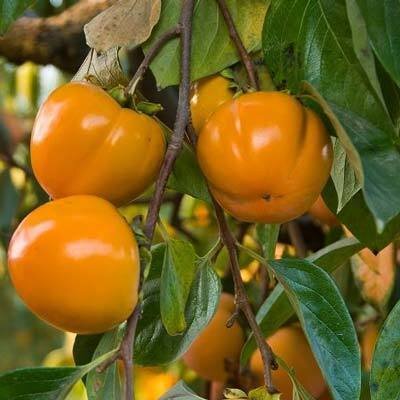Welcome to my Food Forest where I grow an number of fruits in the Bee Better Teaching Garden. Information in this fruit series is based on knowledge I’ve gained growing in hardiness zone 7b, in Raleigh, North Carolina. Helen Yoest
Kind:
Latin Name: Diospyros kaki ‘Fuyu’
Common Name: Japanese persimmon or Kaki
Type: Deciduous Tree
Height: 20 to 30 feet
Spread: 20 to 30 feet
Pollination: Self-pollinating
Fruit Health Benefits: Persimmons are also a good source of thiamin (B1), riboflavin (B2), folate, magnesium and phosphorus. These colorful fruits are low in calories and loaded with fiber, makingthem a weight loss-friendly food
Wildlife Benefits: Persimmon trees often host caterpillars of the beautiful pale green Luna moth. More than 28 other wildlife species eat persimmons.
Origin of species: Kaki is native to India, Burma, China and Korea, and is widely cultivated in Japan.
Cultivars: ‘Fuyu' is by reputation the most popular non-astringent variety in Japan. It produces medium to large fruit that persists on the tree after leaf drop and often into winter. Fruit is mild flavored and sweet. Fruits may be harvested when the skins reach deep orange.
Culture Information:
Sun: Full sun
Water: Medium
Zone: 7 to 10
Years to bear fruit: Up to 7.
Harvest Time: Fall. Fruits may be harvested when the skins reach a deep orange.
Care:
Plant: Somewhat wide range of soil tolerance, but prefers moist, sandy soils, and yet drought tolerant.
Fertilizer/pH: 6 to 7.5. Fertilizer is required only when growth is less than 1 foot per year or in leaves loose their deep green color. When the need for fertilizer is indicated, use a balanced fertilizer – such as 10-10-10 or 10-20-20. Spread 1 pound of the fertilizer for each inch of trunk diameter under the tree canopy in late winter or early spring when new shoots emerge.
Mulch: Mulch in the spring & summer withe about 4-6 inches deep. Keep mulch a few inches away from the trunk of the tree. Good mulch for persimmons is weed-free hay and pine bark. Spacing for persimmons depends upon the desired use in the landscape.
Groom/Prune: Train 'Fuyu' persimmon trees to an open vase system when young to manage the heavy foliage and allow penetration of light and air circulation in the mature tree. Cut newly planted trees back to 36 inches. During summer, when new growth is approximately 4 inches long, select six to eight shoots for the main scaffolding. Branches should be evenly spaced around the tree – like 10, 12, 2, 4, 6 and 8 on an analog clock face – and form wide angles between the branches and the tree trunk. The lowest scaffold branch should be 24 to 32 inches from the ground. Remove all other shoots at the time of pruning and as they develop throughout the summer. Cut back approximately one-third of the length of each scaffold branch the following winter, making cuts just beyond outward-facing buds. Continue to train the tree in this manner. Prune out upward-growing or damaged branches during the dormant season.
Pest/disease Control: No serious insect or disease problems. Scale and mealybug may need to be controlled. Leaf spot may occur.
Propagation: Persimmons are most commonly propagated from seeds and grafts. However, they will also propagate reliably from softwood cuttings if the cuttings are treated with hormone and kept under moderately humid, warm conditions
Comments:
Persimmon trees bear fruit that can make your mouth pucker when unripe or declare its ripe sweetness "the fruit of the gods," according to the translation of its Latin name.
Unripe persimmons of the native American species (Diospyros virginiana) contain tannin, an astringent, so the fruit must be ripened before consumption. Diospyros kaki 'Fuyu,' a Japanese persimmon, is not astringent but develops a richer taste when matured to a soft texture. The flavor has a deep sweetness like honey with a hint of mango.
Anyone who has tried to eat a persimmon before it is ripe will tell you that the extremely bitter taste is something they will never forget. Some folks wouldn't think of eating a persimmon until after a frost; however, frost doesn't have anything to do with the ripeness of the fruit.
Persimmons that are wrinkled and purple are usually very sweet.

